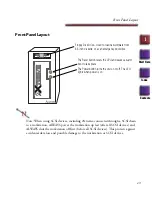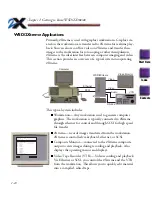
Image Transfer Considerations
1-11
1
Start Here
Index
Contents
Image Transfer Considerations
When you take a computer image created in one drawing program, of
a particular file format, and transfer to a different file format for use in
another drawing program, or convert a 525 line standard television
picture to a 625 line standard picture, there are always limitations
imposed by the transfer. The same is true when images transfer from a
computer to a television environment. Some of the more common
issues encountered in image transfer are discussed below.
n
n
n
n
Line Standards— Computers and workstations often use a
display standard of 1000 lines or more. Television line rates are
typically 525 for NTSC and 625 for PAL. When an image is
converted from one standard to the other, there may be some
loss of resolution. Consult graphics reference texts to learn how
to design graphics that will transfer as smoothly as possible.
n
n
n
n
File Formats— Computer images are usually in RGB format.
For use in video, RGB is converted to YUV (Y, B-Y, and R-Y)
format. Conversion between YUV and Raw RGB, SGI RGB, or
Targa are supported by 2Xtreme.
n
n
n
n
Aspect Ratio— A pixel is the smallest element of a picture
displayed on a television or computer screen. If you think of a
pixel as a brick, then, to build a picture, you need to stack
variously colored bricks one next to the other until you have a
complete image. Unfortunately, all pixels are not the same.
Computer pixels are square. They are basically as tall as they are
wide. NTSC pixels are rectangular. They are about 10% taller
than they are wide. PAL pixels are also rectangular, but, they are
about 10% wider than they are tall.
































